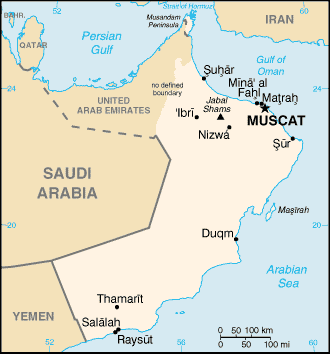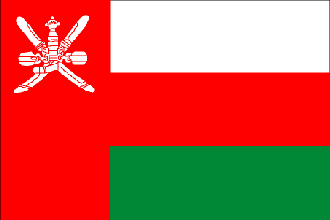
|
Oman
Background:
In 1970, Qaboos bin Said Al Said ousted his father and has ruled as
sultan ever since. His extensive modernization program has opened the country
to the outside world and has preserved a long-standing political and military
relationship with the UK. Oman's moderate, independent foreign policy has
sought to maintain good relations with all Middle Eastern countries.
Location:
Middle East, bordering the Arabian Sea, Gulf of Oman, and Persian
Gulf, between Yemen and UAE.
Geographic coordinates: 21 00 N, 57 00 E.
Area: Total: 212,460 sq km.
Area - comparative: Slightly smaller than Kansas.
Land boundaries: Total: 1,374 km border countries: Saudi Arabia 676 km, UAE
410 km, Yemen 288 km.
Coastline: 2,092 km.
Climate and Terrain:
Dry desert; hot, humid along coast; hot, dry interior; strong
southwest summer monsoon (May to September) in far south.
Central desert plain, rugged mountains in north and south.
Elevation extremes: Lowest point: Arabian Sea 0 m, highest point: Jabal Shams
2,980 m.
Natural resources: Petroleum, copper, asbestos, some marble, limestone,
chromium, gypsum, natural gas.
Land use: Arable land: 0%, permanent pastures: 5%, other: 95%.
Irrigated land: 580 sq km.
People:
Population: 2,622,198 note: includes 527,078 non-nationals.
Ethnic groups: Arab, Baluchi, South Asian (Indian, Pakistani, Sri Lankan,
Bangladeshi), African.
Religions: Ibadhi Muslim 75%, Sunni Muslim, Shi'a Muslim, Hindu.
Languages: Arabic (official), English, Baluchi, Urdu, Indian dialects.
Government:
Monarchy.
Capital: Muscat.
Independence: 1650 (expulsion of the Portuguese).
Economy overview:
Oman's economic performance improved significantly in 2000
due largely to the upturn in oil prices. The government is moving ahead with
privatization of its utilities, the development of a body of commercial law to
facilitate foreign investment, and increased budgetary outlays. Oman continues
to liberalize its markets and joined the World Trade Organization (WTO) in
November 2000.
Labor force: 850,000.
Industries: crude oil production and refining, natural gas production,
construction, cement, copper.
Agriculture - products: dates, limes, bananas, alfalfa, vegetables; camels,
cattle; fish.
Statistics:
Telephones: 201,000.
Telephones - mobile cellular: 59,822.
Radio broadcast stations: AM 3, FM 9, short-wave 2.
Radios: 1.4 million.
Television broadcast stations: 13 (plus 25 low-power repeaters).)
Televisions: 1.6 million.
Internet country code: .om
Internet users: 50,000.
Railways: 0 km.
Highways: Total: 32,800 km paved: 9,840 km (including 550 km of
expressways) unpaved: 22,960 km.
Pipelines: crude oil 1,300 km; natural gas 1,030 km.
Airports - with paved runways: Total: 6.
Airports - with unpaved runways: Total: 137.
Return to Visiting Locations
|

